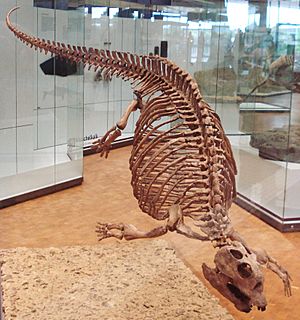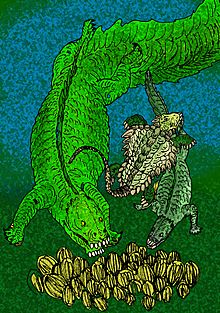Placodont facts for kids
Quick facts for kids Placodont |
|
|---|---|
 |
|
| Placodus, the main type of placodont | |
| Scientific classification | |
| Families | |
|
Cyamodontidae |
Placodonts were a group of ancient reptiles that lived in the ocean during the Triassic period. They are famous for their very heavy, flat teeth. These special teeth were perfect for crushing shellfish, which was their main food.
Placodonts belong to the same larger group as Plesiosaurs, called Sauropterygia. Most placodonts were about 1 to 2 meters (3 to 7 feet) long. Some could grow up to 3 meters (10 feet) long! They lived between 235 and 250 million years ago. Their fossils are found in marine sediments from the Middle and Upper Triassic.
The first placodont fossil was found in 1830. Since then, their remains have been discovered in central Europe, North Africa, the Middle East, and China.
What They Were Like
Body Shape and Protection
The earliest placodonts, like Placodus, lived in the early to middle Triassic. They had a round, barrel-shaped body. Later placodonts developed strong, bony plates on their backs. These plates helped protect their bodies while they were feeding.
By the Upper Triassic, these bony plates had grown much larger. Some placodonts, like Henodus and Placochelys, started to look a lot like modern sea turtles. Other placodonts, such as Psephoderma, also developed plates. However, their plates were arranged differently, looking more like the shells of horseshoe crabs or trilobites.
It's important to know that placodonts were not related to sea turtles, horseshoe crabs, or trilobites. These similar body features are an example of convergent evolution. This is when different animals develop similar traits because they live in similar environments or have similar lifestyles.
Because placodonts had very dense bones and heavy armor, they would have been too heavy to float easily. It would have taken a lot of energy for them to reach the water surface. Also, the types of sediment found with their fossils suggest they lived in shallow waters, not in the deep ocean.
How They Ate
Placodonts were experts at eating shellfish. They had unique teeth for this job. Their front teeth stuck out like spades. They used these teeth to dig up shellfish and pull them off rocks or the seafloor.
Inside their mouths, their back teeth were very large and flat. These teeth worked like a pounding board to crush the hard shells. After crushing the shells, they would swallow the soft parts inside. Their diet mainly included marine bivalves (like clams and oysters), brachiopods, and other invertebrates (animals without backbones).
Images for kids
See also
 In Spanish: Placodontos para niños
In Spanish: Placodontos para niños






